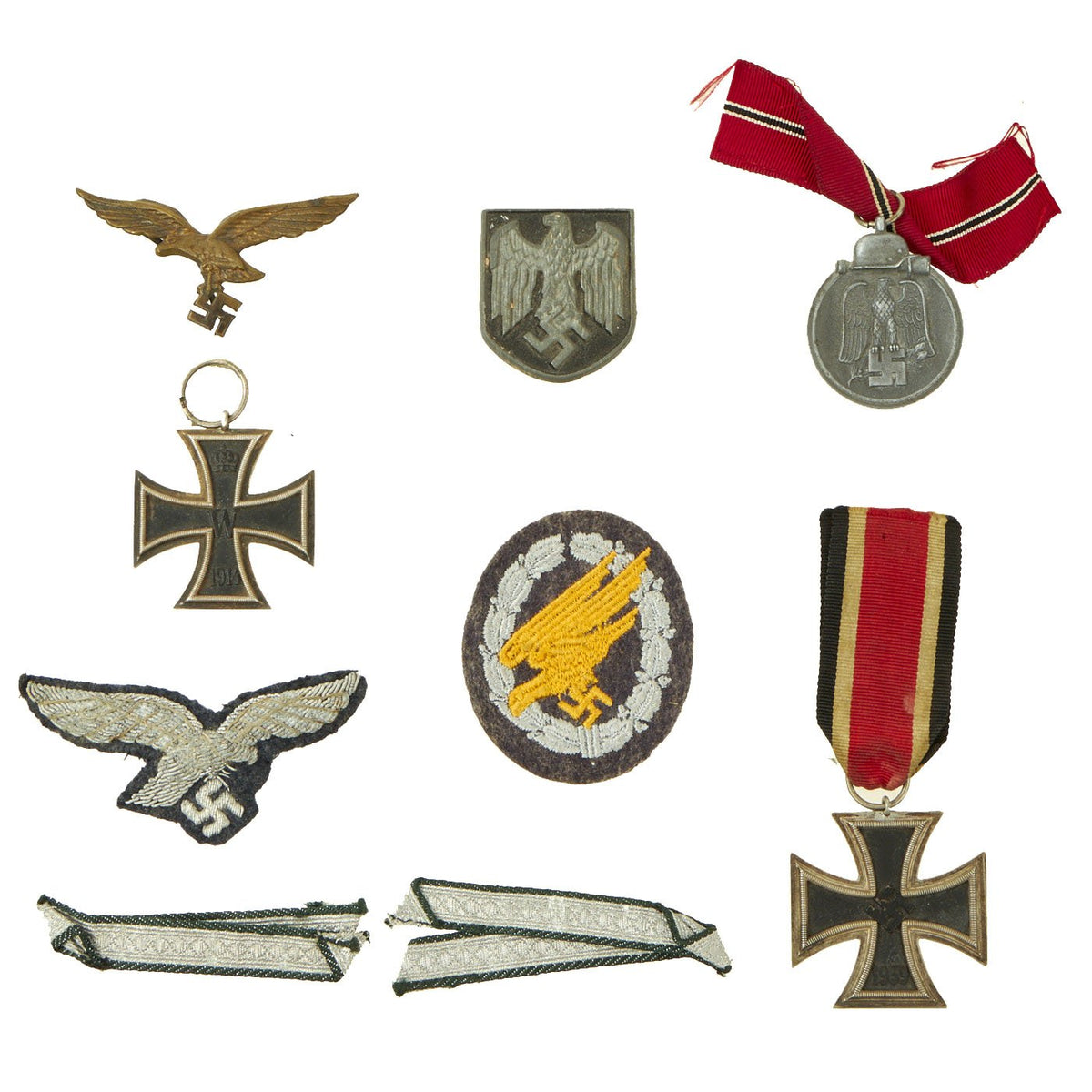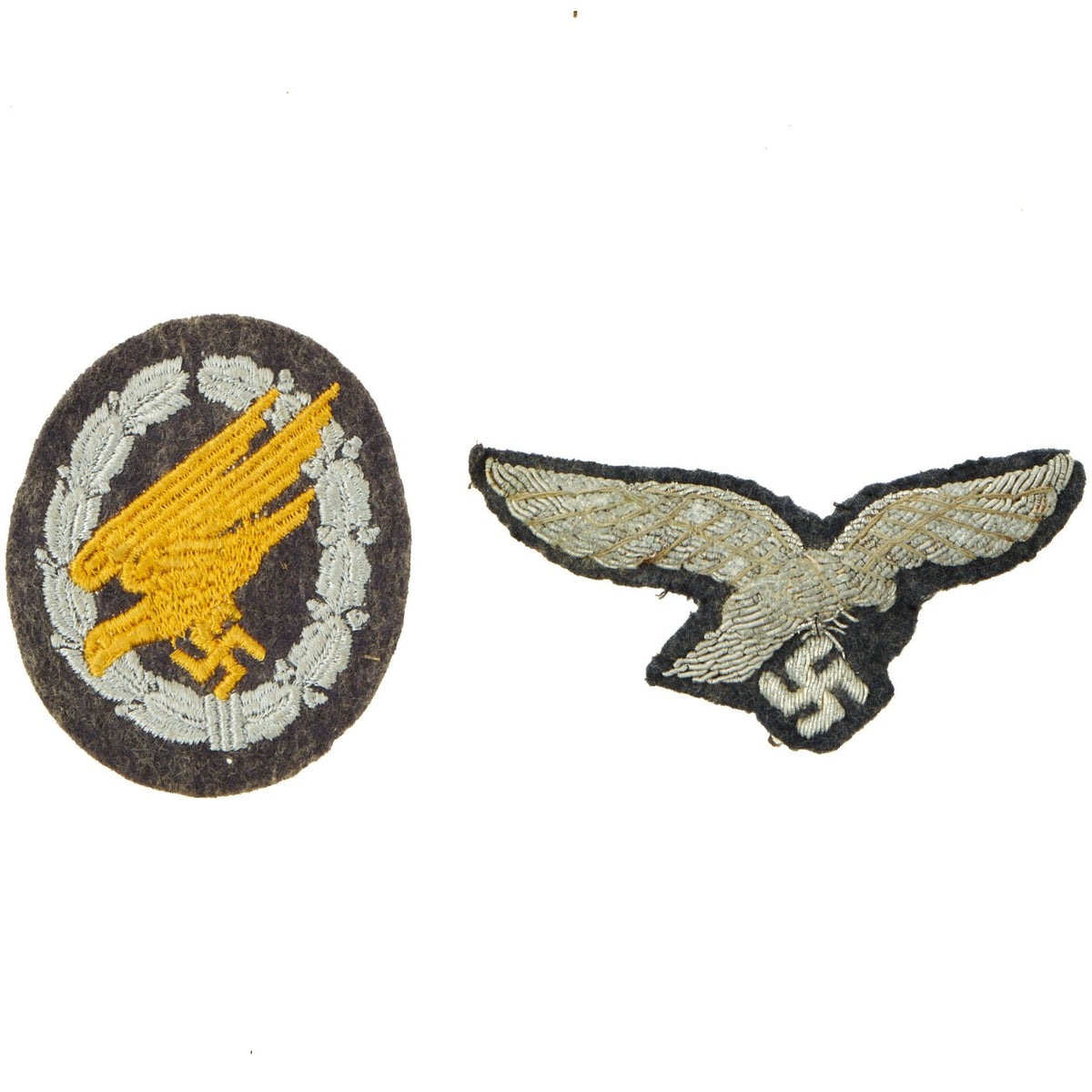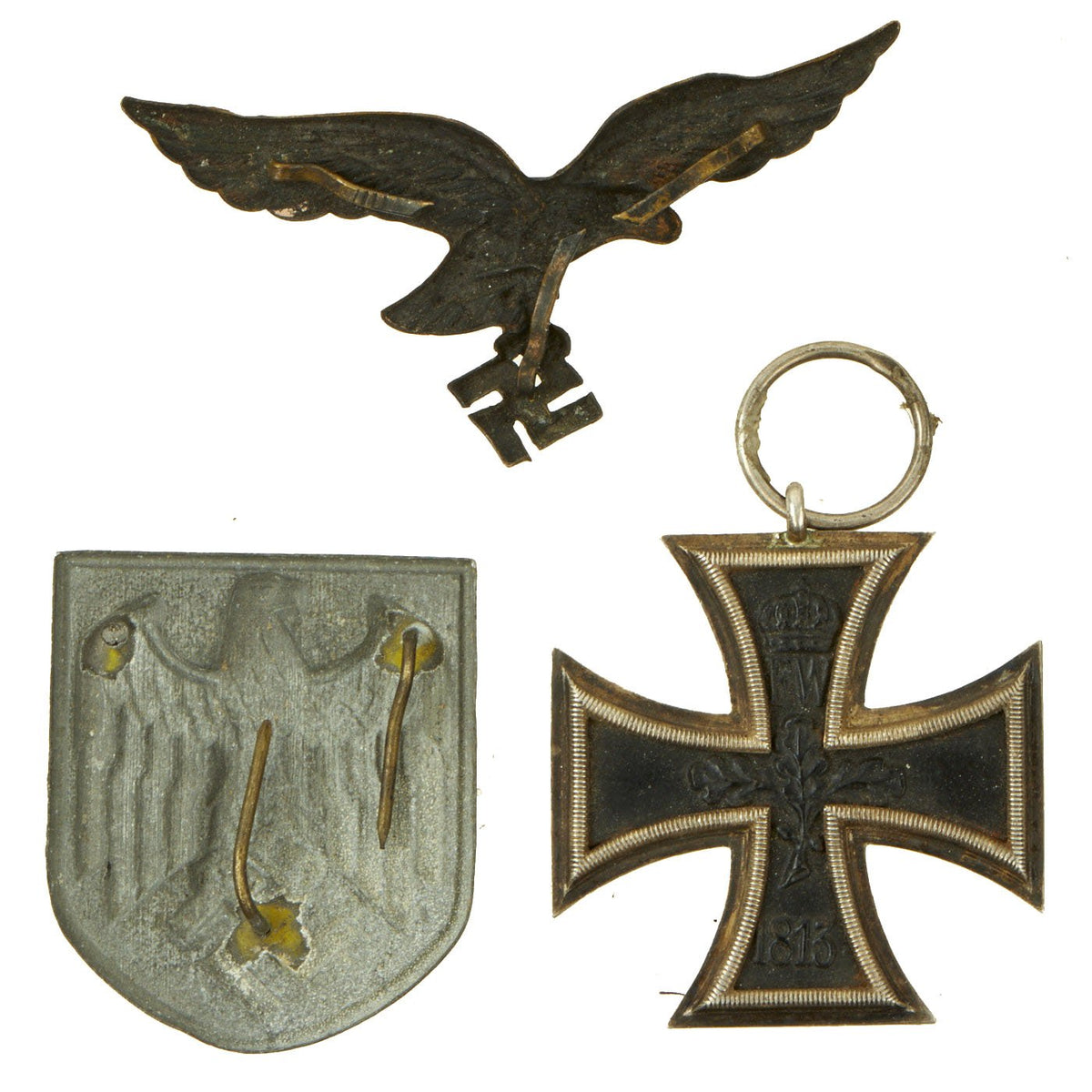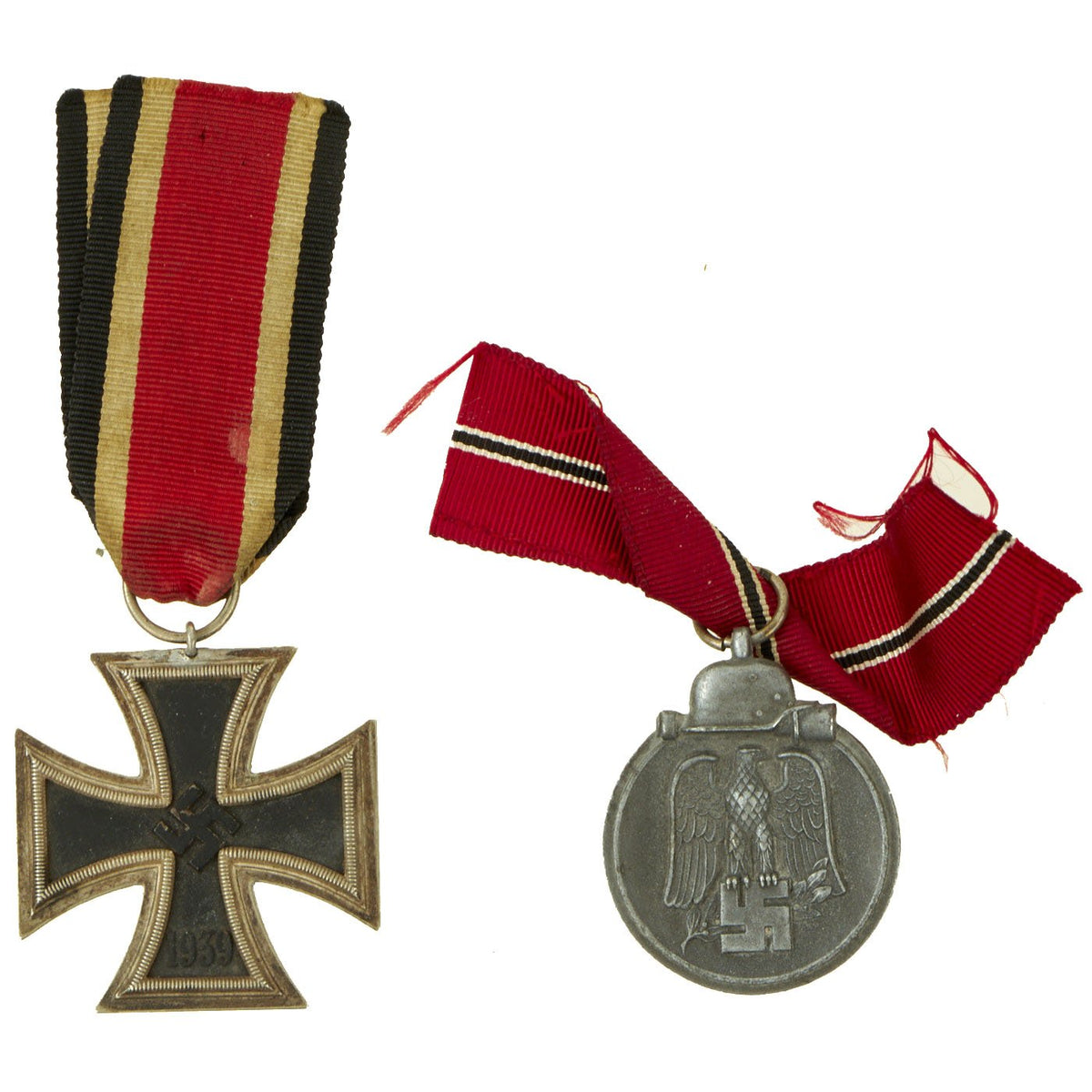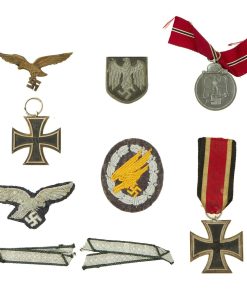Original German WWI & WWII Luftwaffe Paratrooper Insignia Grouping with Iron Cross & Eastern Front Medal Original Items
$ 395,00 $ 118,50
Original Items: Only One Set Available. This is a very nice collection of German WWII Insignia & Awards, which was brought back from the European theater by a USGI after the war was concluded. It includes some lovely Luftwaffe Insignia, including two Luftwaffe Eagles, a Paratrooper Badge, and some Sergeant chevrons. There are also three medals: An Iron Cross 2nd Class 1914, an Iron Cross 2nd Class 1939, and an Eastern Front Medal.
This lovely set includes:
– One Imperial German WWI Prussian Iron Cross 2nd Class 1914 (Eisernes Kreuz II. Klasse 1914). This fine example is in very good condition, with the central cross still retaining almost all of the original paint. It is marked on the rink with maker code 8-W, or possibly M-8, which are unknown makers.
– One German WWII Iron Cross 2nd Class 1939 (Eisernes Kreuz II. Klasse 1939) with Ribbon. This fine example is in very good condition, and is maker marked 27 on the hanger ring, for maker Anton Schenkls Nachfolger of Vienna, Austria.
– One German WWII Eastern Front Medal (Medaille Winterschlacht im Osten 1941/42) with attached Ribbon. This example is in good condition, with a slightly worn ribbon.
– One German WWII Luftwaffe Fallschirmjäger Paratrooper Embroidered Cloth Badge – Parachutist Badge. In very good condition, most likely unissued.
– One German WWII Luftwaffe Bullion Embroidered Breast Eagle. In excellent condition, fully hand embroidered. Features silver bullion thread retained by silver thread. Still has original paper backing, and does not look to have been attached to a uniform at any time.
– One German WWII Luftwaffe Brass Cap Eagle. In very good condition, with some slight bending and all three original clips still present. This is the type used on caps, though they were sometimes seen on sun helmets.
– One German WWII Wehrmacht Eagle Pith Helmet Badge. In good condition, with some slight bending of the zinc body and two of three original clips still present.
– One Pair of German WWII Sergeant Chevrons, made from the correct Bevo style embroidery with silver and green thread.
A wonderful totally genuine grouping perfect for the WWII Luftwaffe German collector.
There is no more iconic German military award than the Iron Cross. The long history of this order began during the Napoleonic Wars. King Friedrich Wilhelm III of Prussia instituted the “Eisernes Kreuz” (Iron Cross) in March of 1813. The award criteria changed somewhat with time, but generally speaking, Iron Crosses could be awarded for individual acts of bravery, or for leadership achievements on the battlefield. The design was created by a Karl Friedrich Schinkel, his choice of the black cross with silver outline was derived from the heraldic emblem of the Teutonic Knights.
Originally, the Iron Cross was an award of the Kingdom of Prussia, however given Prussia’s pre-eminent place in the German Empire formed in 1871, it became an award for all of Germany.
The basic design of the WW1 crosses is a central cross patee struck from iron and mounted in a silver frame which has a raised crenulated decorative border. The obverse of the cross bears the date 1914 under a crowned ‘W’ monogram. Reverse bears an oak leaf cluster with the date of the decoration’s institution, 1813 underneath – the crowned initials of Frederick William are in the top arm above the oak leaf cluster. Suspension for second-class types is by means of a ring, and frequently this ring bears a maker’s stamp.
The final reinstitution of the cross came in 1939. For this version, the front of the core for both grades bore a swas and the date 1939. The oak leaves, crown and royal initials were removed from the reverse, with only the date 1813 remaining as a reminder of the legacy of this award. In WWII, hundreds of thousands of Iron Cross First Class awards were bestowed, and four and a half million Iron Cross Second Class awards. Iron Crosses were made by a large number of authorized manufacturers. Some variants of these awards were mass produced in huge numbers. Others were made in very limited quantities.
Please also note the edge seam for authentication, which is not present on reproductions. Iron crosses were commonly constructed from an iron core sandwiched in a surrounding two part silver frame, normally the seam of these two silver parts is visible around the edge of the cross as is seen on this fine example.
The Eastern Front Medal (German: Medaille Winterschlacht im Osten 1941/42) was a World War II German military decoration awarded to both German and Axis personnel. It was awarded to those who served on the German Eastern Front during the winter campaign period of 15 November 1941 to 15 April 1942 It was instituted on 26 May 1942 and was commonly known as the Ostmedaille (East Medal) or Russian Front Medal.
The medal was wryly called the Frozen Meat Medal or the “Order of the Frozen Flesh” (German: Gefrierfleischorden) by Heer, Luftwaffe and Waffen-SS personnel to whom it was awarded.
Qualification
Armed service personnel qualified for the badge after a minimum of 14 days served in active combat; 30 combat sorties for Luftwaffe members; 60 days of continuous service in a combat zone; being wounded or suffering a “frozen limb”, severe enough to warrant the issue of a Wound Badge. The medal could be awarded posthumously.
The Luftwaffe Parachutist Badge (Fallschirmschützenabzeichen) was a badge awarded to qualified parachutists of the Wehrmacht and the Waffen-SS of NSDAP Germany. The badge was first established by order of Hermann Göring on 5 November 1936. It was originally awarded to Luftwaffe personnel after completion of the required number of six jumps. After this they were eligible to become a Fallschirmjäger (paratrooper).
The badge depicted a diving eagle with a swas in its claws surrounded by a silver wreath. The original construction was made of “gold-finished bronze” for the eagle and “oxidized silver plate” for the laurel leaves. In 1937, the construction of the badge changed to aluminum. In late 1942, the construction was changed again to a metal alloy. A cloth version of the badge was also authorized in 1937, to be worn on a flight jacket. A recipient had to re-qualify for the badge each year.
Fast Shipping with Professional Packaging
Thanks to our longstanding association with UPS FedEx DHL, and other major international carriers, we are able to provide a range of shipping options. Our warehouse staff is expertly trained and will wrap your products according to our exact and precise specifications. Prior to shipping, your goods will be thoroughly examined and securely secured. We ship to thousands clients each day across multiple countries. This shows how we're dedicated to be the largest retailer on the internet. Warehouses and distribution centres can be located throughout Europe as well as the USA.
Note: Orders with more than one item will be assigned a processing date depending on the item.
Before shipping before shipping, we'll conduct a thorough inspection of the items you have ordered. Today, the majority of orders will be delivered within 48 hours. The delivery time will be between 3-7 days.
Returns
The stock is dynamic and we cannot completely manage it because multiple stakeholders are involved, including our factory and warehouse. So the actual stock may alter at any time. It's possible that you may not receive your order once the order has been made.
Our policy is valid for a period of 30 days. If you don't receive the product within 30 days, we are not able to issue a refund or an exchange.
You can only return an item if it is unused and in the same state as the day you received it. You must have the item in its original packaging.
Related products
Uncategorized
Uncategorized
Uncategorized
Uncategorized
Uncategorized
Uncategorized
Uncategorized
Uncategorized
Uncategorized
Uncategorized
Band of Brothers ORIGINAL GERMAN WWII Le. F.H. 18 10.5cm ARTILLERY PIECE Original Items
Uncategorized
Uncategorized
Uncategorized
Uncategorized
Uncategorized
Armored Burgonet Helmet & Polearm from Scottish Castle Leith Hall Circa 1700 Original Items
Uncategorized
Uncategorized
Uncategorized
